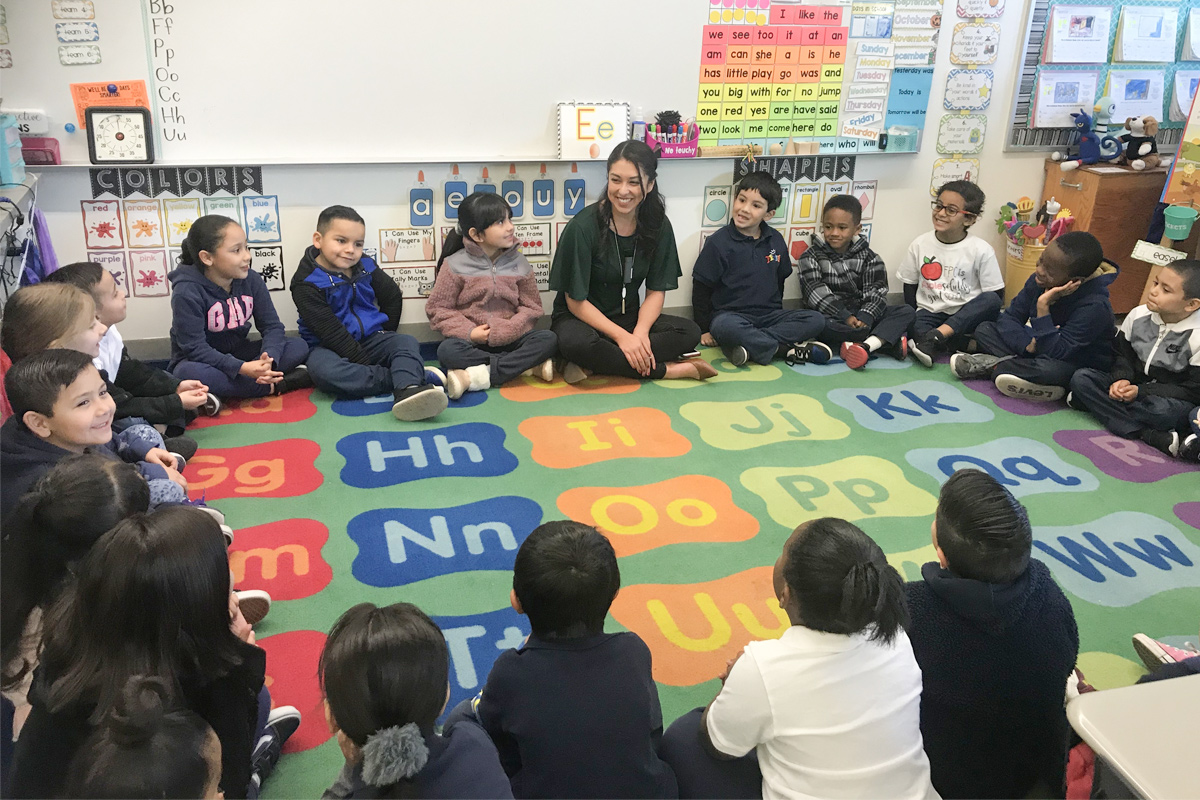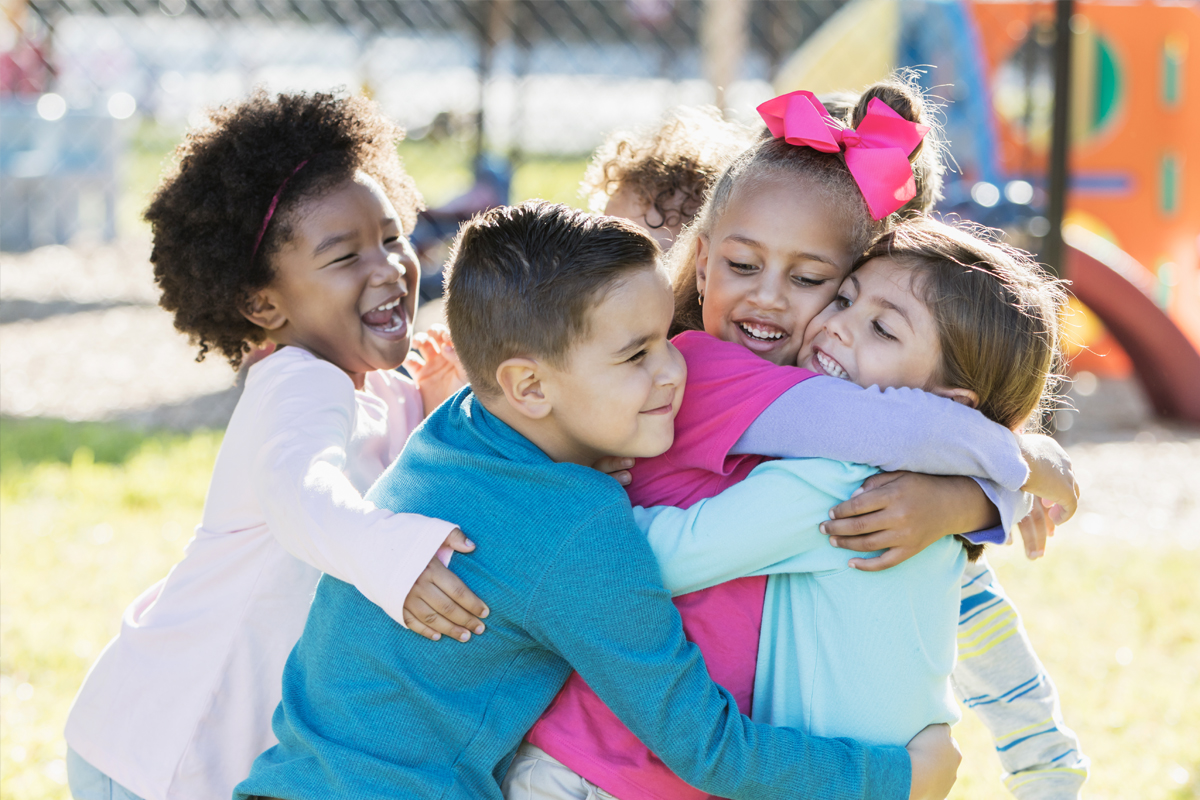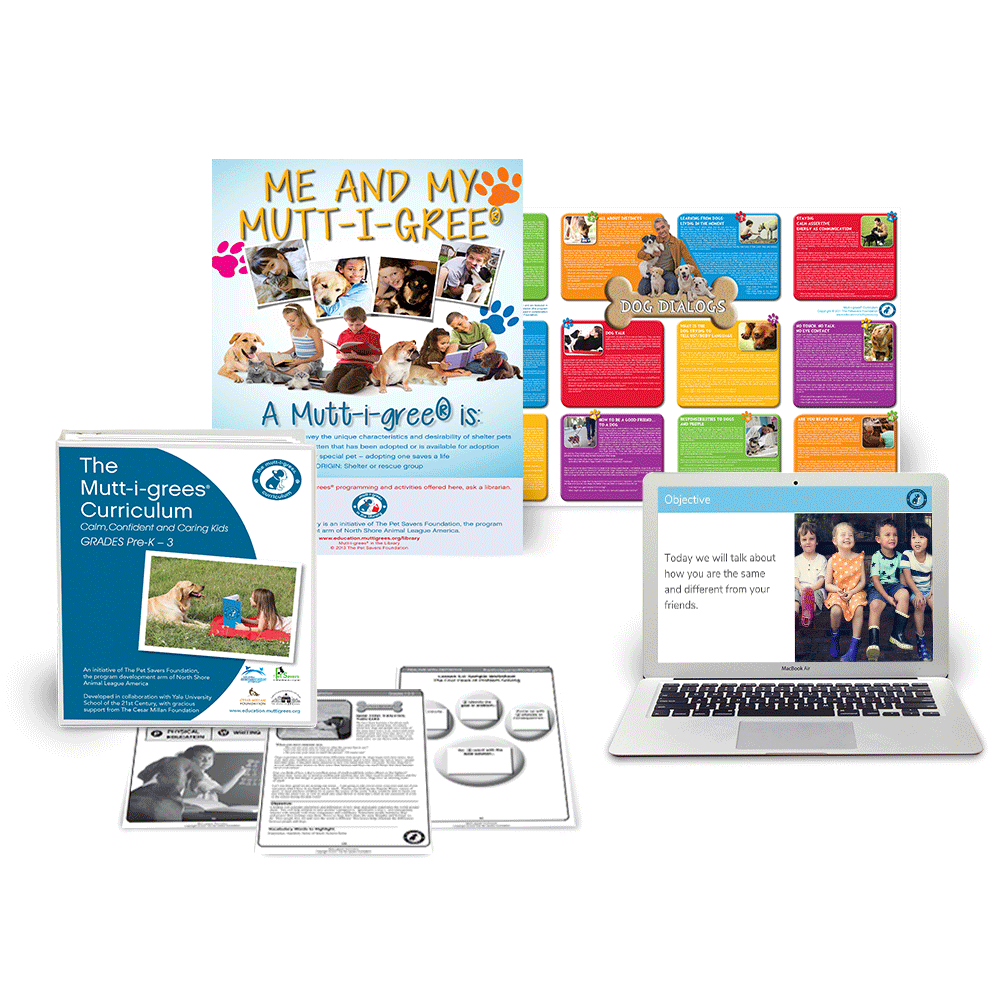The Mutt-i-grees® Curriculum is being used in schools all across the country. Educators have their own methods of integrating the Curriculum to build social emotional competence in their students. Nina Ferman of Fenton Primary Center in Los Angeles, CA shared her experience with the Mutt-i-grees Curriculum and its impact at her school.

1. How long has your school been involved with the Mutt-i-grees Curriculum?
Fenton Primary Center was one of the 35 schools involved with piloting the Mutt-i-grees Curriculum in 2010.
2. Can you tell us the involvement you’ve had with the Mutt-i-grees Curriculum?
While all classrooms in our school teach the Mutt-i-grees Curriculum, Fenton Primary Center has a Mutt-i-grees Team comprised of a few teachers and administrators, with a main point person, whom we call the “Mutt-i-grees Lead.” The role of the Mutt-i-grees Team within our school is to train any new staff member on the curriculum, provide refresher training for all teachers, and oversee the implementation of school-wide, Mutt-i-grees-related events throughout the school year. I have been a member of my school’s Mutt-i-grees Team since 2013, but this is my first year assuming the role of Mutt-i-grees Lead here at Fenton Primary Center.
Together with my Mutt-i-grees Team, I help oversee staff training (either new teacher training, or a Mutt-i-grees Refresher training for experienced teachers) and plan Mutt-i-grees-related events. For example, two months ago we had a Mutt-i-grees Refresher training for all our teachers. We called it “Fenton Primary Center’s Mutt-i-grees Mission 2019-2020.” In this training, we refocused on the mission, purpose, and benefits of the Mutt-i-grees Curriculum, demonstrated how to incorporate Mutt-i-grees into our busy lesson plans, modeled the parts of a Mutt-i-grees lesson (which includes the amazing updated slides available on the Mutt-i-grees website), shared how to access digital activities to go along with the lessons, and discussed the details of the upcoming Mutt-i-grees-related events in our school: National Mutt Day, Pack Party Week (our school’s holiday theme this year was a Mutt-i-grees Christmas, which we titled “Happy PAW-lidays!”), and an animal shelter Donation Drive and Fundraiser (for which we raised $1,020.00.) See these events on Fenton Primary Centers’ Instagram account. For each event, we are careful to make it exciting but also to ensure we promote empathy via the humane treatment of shelter animals.
3. Can you tell us a few ways you’ve used the Curriculum in the classroom?
I teach kindergarten here at Fenton Primary Center, and have been teaching the Mutt-i-grees Curriculum to my students for seven years now. My goal is to teach a Mutt-i-grees lesson three times a week, so that its implementation is consistent and my students are benefitting from the social-emotional lessons as much as possible. Sometimes it takes me dividing a lesson into three different days to teach it thoroughly and adhere to my schedule, but I love that I am easily able to fit Mutt-i-grees into my lesson plans.
I start each lesson by asking my students what a mutt-i-gree is (a mixed-breed animal awaiting adoption in a shelter). Then, we sing the Mutt-i-grees Song. From there, I launch into the presentations with the aid of our Mutt-i-gree Puppet. I use a combination of presentations I had already created for each lesson, as well as the wonderful, updated presentations available to users on the Mutt-i-grees website. Each grade-level in Fenton Primary Center has a shared Google Drive, where we upload activities for each lesson. This collaboration makes it easier for us to share our Mutt-i-grees projects and activities with our grade level teachers.
Because of my student’s love for the Mutt-i-grees Curriculum, they enjoy finding ways to incorporate lessons intentionally throughout the day. For example, in kindergarten, Mutt-i-grees Unit 1 Lesson 5 is titled “What I Like About You.” In this particular lesson, students learn the importance of sharing what they like about others and lifting others up (the previous lesson teaches students to identify & focus on what they like about themselves, which encourages self-love and confidence).

My students sat in our Community Circle and passed around the Mutt-i-gree Puppet. Whoever held the puppet was the person we would focus on complimenting. Each student heard their peers telling them why they liked them. It is always so heartwarming to hear what they say, as they either name a physical characteristic such as “I like your smile,” or a character trait such as “I like that you are always nice to me.” They have never been unable to find something nice to say about a peer. From there, I asked my students how we can practice lifting each other up every day. They came up with the idea of stopping to clap and cheer for anyone who moves their behavior clip to blue (moving a behavior clip to blue in our school means exemplary behavior). They also cheer for and high-five each other when they conquer a difficult math problem, improve in a subject area, or receive any kind of recognition. Ever since that lesson, they spend the entire year looking to lift each other up, and this includes myself and the adults who work with my students as well. They are eager to compliment us, see how it brightens our disposition, and they make friends more easily because they are practicing kindness. This is just an example of the impact I have seen from one Mutt-i-grees lesson that we thoroughly analyzed, but I have countless examples.
Additionally, since the Mutt-i-grees Curriculum connects students to the plight of shelter animals, students express a strong sense of love, concern, and empathy for these precious animals. We just completed a school-wide donation drive for two local animal shelters in December. Students helped us raise money to donate to these shelters as well as collect canned/dry pet food, blankets, towels, and toys for donation. In the classroom, this naturally led to a lot of discussion about students’ ability to make a difference in the world and in their community, no matter how young they are. Students were proud and happy to donate in whatever way they could (some could not donate items, but decided on their own to make cards and drawings for the shelter animals telling them they love them). Many of their parents even shared with me that their child asked them to adopt a mutt-i-gree for Christmas, and that they talk about the program extensively at home.
There are so many possibilities with using the Mutt-i-grees Curriculum in the classroom. For example, on National Mutt Day, each classroom in our school was visited by one of six therapy dogs that celebrated on our campus that day. My students learned dog etiquette from the owner who visited our classroom. He taught them how to approach a dog on leash by first asking the owner if it is okay to pet their dog, and then how to do so in a way that does not startle the dog or make them uneasy. We also read mutt-related books to students, including Gray Whiskers, Love Me Gently, Tommy the Throwaway Dog, and Can I Be Your Dog? The curriculum is about social-emotional skills, but also awareness for shelter animals and how we can inspire a generation of mindful, compassionate pet owners.
4. How have the students reacted to the program? Have you found the focus on animals to be a draw for your children to engage more?
I start each morning by reviewing our daily schedule with my kindergarteners. Each day includes Language Arts and Math, with subjects such as Art, Music, Physical Education, Social Studies, Science, and Mutt-i-grees varying from day to day. Whenever my students see Mutt-i-grees on our daily schedule, they literally cheer aloud. It’s the only subject that elicits that level of excitement, despite their fondness for other subjects. I have found that universally, my students always love the Mutt-i-grees Curriculum. The focus on animals is a huge draw for them to engage with the curriculum’s teaching of social-emotional skills. They also show an increased interest and compassion for their own pets at home, and will share stories with me about how they insist their pets be walked because they also need exercise, that they always have clean water and a warm bed, etc. Social-emotional learning is crucial, but teaching these skills with a focus on shelter animals is what draws my students in and keeps them engaged with learning and practicing these skills.
“I have found that universally, my students always love the Mutt-i-grees Curriculum. The focus on animals is a huge draw for them to engage with the curriculum’s teaching of social-emotional skills.”
5. If you had to tell another educator why they should implement the Mutt-i-grees Curriculum, what would you say?
Every educator is familiar with the increased emphasis on academic achievement. We went from State Standards to Common Core Standards, curriculums are always changing, and we are constantly learning new strategies to address gaps and/or deficits in academic achievement. With so much importance being placed on academic achievement, it becomes all too easy to overlook teaching to the whole child and addressing how to navigate their feelings, communicate with others, practice self-love, foster empathy, etc. Teaching these key skills is why most educators became teachers in the first place. We felt a need to teach children, not curriculum. The Mutt-i-grees Curriculum helps you teach to the whole child. For me, it is much more fulfilling and rewarding to teach my students social-emotional skills such as empathy, compassion, resilience to obstacles, how to calm down when angry, how to manage sadness and stress, etc, than it is to teach them what an adjective is.
When I look at the needs in society, I feel gratitude for this program that my students love and benefit from. I listen to their conversation, they understand when I redirect them with previously taught mutt-i-grees lessons, and it is easy to inspire empathy through connecting them to the plight of shelter animals. I see increased empathy in my students, as well as emotional awareness. The curriculum is there for you. It helps you support your students and is a teacher’s best friend when it comes to teaching kindness and social-emotional skills to children. The lessons are online and straightforward, they can easily be supplemented, and if you form a team in your school, you can make the curriculum whatever you want it to be. The possibilities with the Mutt-i-grees Curriculum are endless, and I highly recommend it to any educator. Our focus should be on raising a generation that has compassionate leaders, and that is the goal of the Mutt-i-grees Curriculum.
6. Do you see Mutt-i-grees as an answer to the bullying problem in schools?
Absolutely! While there is no quick-fix to the bullying problem in schools, if you look at the root of bullying issues, they stem from a lack of compassion, empathy, kindness, and overall social-emotional awareness. Bullying is a symptom of broken relationships. What the Mutt-i-grees Curriculum does is address social-emotional learning, which a lot of students do not receive explicitly at home. These are usually the students who are unkind to their peers and who struggle to build healthy relationships with others. All educators have students in their class who struggle with building healthy, safe relationships with others. With all the academic concerns we address as teachers, it becomes difficult to find the time to explicitly address the social-emotional skills our students are lacking. This is when teachers begin to feel like they are fixing parenting issues and cannot “get through” to a student who is not showing or practicing empathy, learning to make friends, etc. When my class has instances of bullying, it is easier for me to redirect my students because when I ask them how the incident may have made others feel, they are able to tell me. This is largely due to practicing these skills so much during Mutt-i-grees lessons (addressing feelings, practicing empathy, etc). However, this teaching has to be consistent. All teachers try to address these issues, but the consistency you get from the Mutt-i-grees Curriculum helps with preventing instances of bullying as well as addressing issues that do occur more easily. I have found that when I truly hold myself and my students accountable to practicing what we learn in each lesson, and when we revisit topics, they make those instant, real-life connections. It absolutely does work. Furthermore, if a school can have an actual therapy dog on campus (which is our next goal), studies show that when children are in the presence of dogs or even thinking about dogs, they are calmer and happier. Students who are truly calm and happy do not bully others.
“I have found that when I truly hold myself and my students accountable to practicing what we learn in each lesson, and when we revisit topics, they make those instant, real-life connections.”
7. Do you think that this sort of social emotional learning has an effect on academics, or do you see the two areas as separate?
Every teacher eventually comes to the realization that learning is a skill. Some people are more skilled in learning than others. There are students who have the same concept taught and shown to them in various ways, using different modalities and strategies, but because they are constantly not engaged or interested in the material, they are not strengthening their learning skills and fall further and further behind. For those students, this usually translates into all or most academic subjects, and is very difficult for an educator to undo. I definitely see the highest levels of engagement in my class when I launch into a Mutt-i-grees lesson. I see my students who are uninterested in most other subjects and who are struggling to learn instantly perk up and want to engage and participate. Students need to know why learning a new concept is important, and they need to find the material stimulating.
When we introduce a new lesson for any subject, we start by telling students the objective and why it’s important for them to know this. With Mutt-i-grees, it seems the most obvious to them. Ultimately, the purpose is to help them interact better with themselves and those around them (people and animals). People, especially children, want to feel connected to others and accepted as they are. The discussions we have during Mutt-i-grees lessons keeps my students focused and happy. They love learning about these living, loving examples of resilience. I don’t see the areas as separate as all. In fact, studies show that teaching social-emotional skills has positive academic, interpersonal, and mental health outcomes. A Harvard University study, titled Navigating SEL from the Inside Out: Looking Inside & Across 25 Leading SEL Programs, found that “classrooms function more effectively and student learning increases when children have the skills to focus their attention, manage negative emotions, navigate relationships with peers and adults, and persist in the face of difficulty. Children who are able to effectively manage their thinking, attention, and behavior are also more likely to achieve better grades and higher standardized test scores.” This study found the Mutt-i-grees Curriculum to be one of the most impactful programs teaching social and emotional skills, and I have definitely witnessed its countless benefits in my students.
8. Do you find that the results of Mutt-i-grees carries over outside the classroom?
The results of the Mutt-i-grees Curriculum definitely carries over outside the classroom. I see it in the reduced behavior issues and increased social-emotional awareness, but also in the way my students view their ability to make a difference in our community. For example, our Canned Food, Blanket, & Towel Donation Drive in December called for students to collect as much canned dog/cat food, blankets, and towels to donate to two local animal shelters. Since our students have been learning so much about the plight of shelter animals, they were all determined to help as much as they could. They brought in so much food for the mutt-i-grees, as well as many new or used towels, blankets, and they even went above and beyond and donated beds, toys, collars, pet clothes, etc. Many of my students handed me drawings (without any prompting) and cards they had made and asked me to deliver it to the shelters as well when I delivered the items. They had drawn pictures for the mutt-i-grees and notes telling them how much they love them and wish they get adopted.
“Discussing shelter animal awareness and advocacy is already impacting our students here at Fenton Primary Center, and I can see that they will grow up to be a generation of more mindful, responsible, and compassionate pet owners.”
Additionally, I have found that students naturally connect the plight of mutt-i-grees to homelessness in general. Kindergarteners are very candid. During Mutt-i-grees lessons, they will talk to me about their concern for the homeless people they observe, which is not a topic I bring up but that their minds wander to. This shows me that empathy for animals also translates to empathy for mankind. Their parents often tell me that their child is asking them to adopt a shelter animal, or that they are more affectionate with and protective of their own pet. I also see that my students are speaking to each other with increased kindness and are mindful of including everyone. The social-emotional learning that is fostered with the Mutt-i-grees Curriculum absolutely carries over outside the classroom, which is why our teachers and students here at Fenton Primary Center love the curriculum so much.



